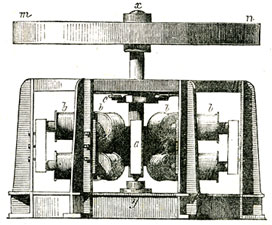Pouillet’s Electromagnetic “Tour”
Édouard-Léon Scott de Martinville was the first person to record sound vibrations from the atmosphere via a membrane. However, others before him had recorded the vibrations of sounding bodies at their point of origin by attaching a stylus directly to a string or bell or tuning fork. Nineteenth century acousticians associated this approach with Jean-Marie Constant Duhamel, who had drawn widespread attention to it through a series of experiments published in 1840. But when Scott invented the phonautograph he seems to have been unaware of Duhamel’s work. Instead, he refers back in his early writings to the work of Guillaume Wertheim (1842) and to the electromagnetic “tour” of Pouillet.
Wertheim’s vibrographic research was well known at the time, and Claude Servais Mathias Pouillet (1791-1868) was a prominent physicist. However, Pouillet’s contribution to sound recording was fairly obscure—so obscure, in fact, that we weren’t even sure at first what Scott meant by a “tour.” Further research has now uncovered the story behind Scott’s puzzling reference.
In 1850, Pouillet published a book called Notions générales de physique et de météorologie à l’usage de la jeunesse. In it, he describes a method for determining the numerical frequencies corresponding to the notes of the musical scale. Step one: procure a tuning fork for each note in the octave and attach a stylus to one of the prongs. Step two: set up an electromotor that causes a wheel with an inked circumference to revolve at a constant rate. Step three: set the first tuning fork into vibration and hold it up to the circumference of the wheel to record its vibrations by scraping away the ink. Step four: count the number of vibrations the fork recorded in one second. Step five: repeat with the other tuning forks. Pouillet reports his results as 528, 594, 660, 704, 792, 880, 990, and 1056 simple vibrations (i.e., double the value in Hz).
He also published an image of a sample waveform. This could be a facsimile of an actual recording Pouillet had made in the way he described. If so, it is arguably a “record” of the vibrations of a tuning fork made before the invention of the phonautograph. It dates, though just barely, from the first half of the nineteenth century.
First Sounds collaborator Patrick Feaster acquired a copy of the 1852 edition of Pouillet’s book, which used the same printing plate as the 1850 edition (the 1860 edition substituted a different plate). He prepared a high-resolution scan which Earl Cornell at Lawrence Berkeley National Laboratory then converted into sound. Pouillet did not specify a frequency for his sample waveform, so our sound file repeats it eight times, once at each of the eight frequencies making up Pouillet’s octave. Apart from this, we have done nothing to even out the playback speed: what you hear is essentially played straight off the page.
Is the sound recognizably like that of a tuning fork? Not really. But the fact that we can hear pitches at all, rather than just noise, points to the success of Pouillet’s experiment on its own terms.
Listen: Waveform inscribed by Claude-Servais-Matthias Pouillet, 1850 (mp3)

Above: Pouillet’s recording diapason

Above: Pouillet’s electromotor

Above: Pouillet’s sample waveform
For more visual recordings and good stories from this author, see Patrick Feaster's Grammy-nominated Pictures of Sound.
